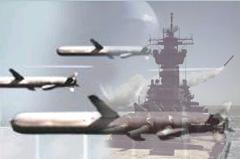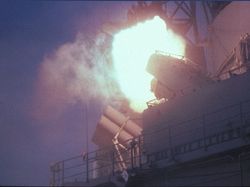Fri, Oct 01, 2004
Navy Welcomes New Ordnance To The Fleet
 The US Navy Wednesday welcomed
Raytheon Company's Tomahawk Block IV cruise missile into its
arsenal at a fleet introduction ceremony in the Pentagon. The Block
IV officially achieved initial operating capability (IOC) on May
27, 2004, with the loading of the first missile onboard USS Stethem
(DDG-63), a guided missile destroyer.
The US Navy Wednesday welcomed
Raytheon Company's Tomahawk Block IV cruise missile into its
arsenal at a fleet introduction ceremony in the Pentagon. The Block
IV officially achieved initial operating capability (IOC) on May
27, 2004, with the loading of the first missile onboard USS Stethem
(DDG-63), a guided missile destroyer.
"The Block IV Tomahawk provides a substantial battlefield edge
to our warfighters," said Navy Capt. Bob Novak, Tomahawk
All-Up-Round program manager. "It is a great day for the Navy to
formally celebrate the hard work of the Navy-Raytheon team that
enabled the fleet introduction of this revolutionary weapon, whose
flexible targeting and loitering capabilities build on the
tremendous 32-year tradition and success of the legacy Tomahawk
program."
"Raytheon is proud to provide the Navy with this new weapon with
expanded warfighting capabilities that position weapons as nodes in
the integrated network of the future battlespace," said Louise L.
Francesconi, Raytheon Missile Systems president. "The Block IV
Tomahawk is the result of the collective commitment of the Navy and
Raytheon to provide affordable, operational capabilities for
critical long-range, precision strike missions."
Block IV Tomahawk is the centerpiece of the Navy's new Tomahawk
Baseline IV Weapons System. The system integrates the Block IV
missile with improved mission planning and platform weapons control
capabilities. This latest version of the Navy's surface- and
submarine-launched precision strike standoff weapon incorporates
innovative technologies to provide unprecedented operational
capabilities while dramatically reducing acquisition, operations
and support costs. The Block IV costs less than half the price of a
newly built Block III missile. Additionally, the Block IV missile
will have a 15-year warranty and recertification cycle, compared to
the Block III variant's eight-year recertification cycle.
 The new capabilities that Block IV
Tomahawk brings to the Navy's sea strike capability are derived
from the missile's two-way satellite data link that enables the
missile to respond to changing battlefield conditions. The strike
controller can "flex" the missile in flight to preprogrammed
alternate targets or redirect it to a new target. This targeting
flexibility includes the capability to loiter over the battlefield
awaiting a more critical target. The missile can also transmit
battle damage indication imagery and missile health and status
messages via the satellite data link. For the first time, firing
platforms will have the capability to plan and execute Global
Positioning System-only missions. Block IV will also introduce an
improved anti-jam GPS receiver for enhanced mission
performance.
The new capabilities that Block IV
Tomahawk brings to the Navy's sea strike capability are derived
from the missile's two-way satellite data link that enables the
missile to respond to changing battlefield conditions. The strike
controller can "flex" the missile in flight to preprogrammed
alternate targets or redirect it to a new target. This targeting
flexibility includes the capability to loiter over the battlefield
awaiting a more critical target. The missile can also transmit
battle damage indication imagery and missile health and status
messages via the satellite data link. For the first time, firing
platforms will have the capability to plan and execute Global
Positioning System-only missions. Block IV will also introduce an
improved anti-jam GPS receiver for enhanced mission
performance.
The Navy and Raytheon have entered into a five-year multi-year
procurement contract to replenish Tomahawk inventory at the most
affordable cost. The Tomahawk missile is the Navy's weapon of
choice for critical, long-range precision strike missions against
high value, heavily defended targets.
More News
Also: ANOTHER Illegal Drone, KidVenture Educational Activities, Record Launches, TSA v Shoes The Senate confirmed Bryan Bedford to become the next Administrator of the FAA, in a ne>[...]
Also: Sully v Bedford, Embraer Scholarships, NORAD Intercepts 11, GAMA Thankful Middle Georgia State University will be joining the Federal Aviation Administration’s fight ag>[...]
Also: DarkAero Update, Electric Aircraft Symposium, Updated Instructor Guide, OSH Homebuilts Celebrate The long-awaited Sonex High Wing prototype has flown... the Sonex gang tells >[...]
Also: Sully v Bedford, Embraer Scholarships, NORAD Intercepts 11, GAMA Thankful Middle Georgia State University will be joining the Federal Aviation Administration’s fight ag>[...]
30-Year USCG Veteran Aviator Focusing On Member Benefits The Vertical Aviation International Board of Directors announced its new leadership officers in April, and all began their >[...]
 Airborne 07.11.25: New FAA Boss, New NASA Boss (Kinda), WB57s Over TX
Airborne 07.11.25: New FAA Boss, New NASA Boss (Kinda), WB57s Over TX Airborne-Flight Training 07.10.25: ATC School, Air Race Classic, Samson School
Airborne-Flight Training 07.10.25: ATC School, Air Race Classic, Samson School Airborne Affordable Flyers 07.03.25: Sonex HW, BlackShape Gabriel, PRA Fly-In 25
Airborne Affordable Flyers 07.03.25: Sonex HW, BlackShape Gabriel, PRA Fly-In 25 Airborne-Flight Training 07.10.25: ATC School, Air Race Classic, Samson School
Airborne-Flight Training 07.10.25: ATC School, Air Race Classic, Samson School Rick Kenin New Board Chair of VAI
Rick Kenin New Board Chair of VAI




